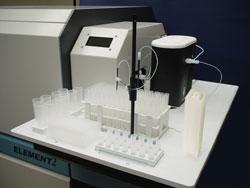|
Instrument Database:
Elemental Scientific Inc. (ESI) - SC-E2 Integrated Autosampler
| |
|

|
| |
|
| |
|
| Year of introduction |
|
| Status |
available |
| Company |
Elemental Scientific Inc. (ESI)
|
| Categories |
Automation: Autosampler (Flame/ICP)
|
|
| | The SC-E2 is the first sample tray with an integrated autosampler designed to fasten directly onto the existing Element2 factory mounting points. The chemically resistant sample tray increases usable sample space by over 3x and includes an integrated drain to channel waste directly to the waste container. The entire tray and autosampler moves with the swinging door allowing easy access for cone maintenance. It can accommodate a variety of sample inlet systems as well as hold up to 2 standard racks or 4 micro racks. - Mounts directly to Element2 for easy maintenance and saving valuable space.
- Dual flowing rinse station, mimics best manual rinse procedure, ensuring fast washout of the previous sample and minimal blank contamination.
- Rigid probe, that can accurately enter small vials without the need for a probe guide
- Small probe length and short sample tubing improves uptake and washout. Ideal for self aspirating nebulizers.
- Controls the FAST flow injection accessory for high sample throughput or chromatography applications
- Holds a variety of vials from 0.5mL microcentrifuge tubes to 250mL tall bottles
- Increases work area by 3 fold and can accommodate from 384 samples x 4mL to 20 samples x 250mL.
- Accommodates up to 10 Standards.
Options Available: SC-FAST Rapid analysis system for increasing throughput, integrating chromatography systems and reducing salt loading of ICP-MS cones. Enclosure Protective cover protecting samples from airborne contaminations. ULPA filtered available on request. PFA Rinse Delivery System Pressurized rinse cleaning system, giving the lowest possible rinse contamination Encoder Allows direct reading of probe location at all times. Ensures no vial is ever missed. Rack Type A variety of racks are available for SC-E2 |
|